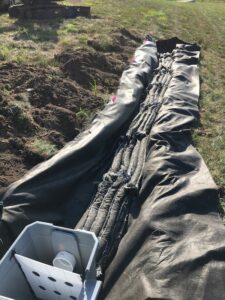Kate Trauth, associate professor of Civil and Environmental Engineering, and Ginny Trauth, an MU Civil and Environmental Engineering Department graduate, founded Infiltronics Environmental a few years ago with the goal of developing a device to better manage stormwater.
Reducing stormwater runoff headed straight to a stream reduces pollutant transport to the stream and potential infrastructure damage. The Trauths’ device works by spreading out the stormwater, relocating it to locations on a site where it can naturally soak into the soil. This is not only a better alternative environmentally, it also can lower stress on taxed sewer systems.
“Our device serves to undo the natural processes that concentrate stormwater, such as when you see it coming off of a parking lot,” explained Kate Trauth.
Infiltronics received a patent for the device and is now in the process of collecting data and refining the design.
“We conducted lab testing, and had promising results. Then we started looking for installation sites. We put a system of devices in at Father Tolton High School in Columbia last August,” Ginny Trauth said.
With a signed agreement from the Missouri Department of Natural Resources’ Division of State Parks, the duo is set to install two systems of devices at Rock Bridge Memorial State Park, also in Columbia. “The focus of this work [at Rock Bridge] is continuing our research, increasing stormwater education and trying to improve stormwater conditions at those sites.”
The company is working to lock down additional funding through a Kickstarter campaign to aid the state park setup and execution, including the purchase of soil moisture sensors and raw materials. The device uses sand and gravel in various partitioned compartments of geotextile fabric to create new avenues for the water to flow, guiding it to more optimal locations. The Trauths have installed their system and worked to improve it based on hundreds of interviews with industry leaders made possible through a National Science Foundation I-Corps grant.
“We’re playing with a whole range of variables to see how they fit together. Every installation will be site specific because every site is different,” Ginny Trauth explained. “The first install [at Tolton High School] works with rain coming off of a roof. At Rock Bridge, we’re trying to manage overland flow, as well as a type of concentrated stormwater flow coming from a culvert along a road.”
“The two new sites are larger and use different approaches, and we’re interested to see how they turn out,” Ginny Trauth said. “We’ll be instrumenting the sites to understand how the water moves through the devices to improve the design for greatest effectiveness.”
